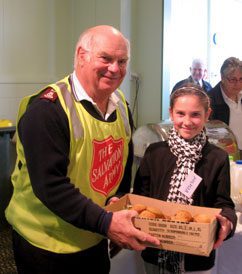Listen to this article
Listen to this article
Loading
Play
Pause
Options
0:00
-:--
1x
Playback Speed- 0.5
- 0.6
- 0.7
- 0.8
- 0.9
- 1
- 1.1
- 1.2
- 1.3
- 1.5
- 2
Audio Language
- English
- French
- German
- Italian
- Spanish
Open text
salvation army responds after tornadoes rip through midwest south. tornado outbreak sequence spans five days. by jeff curnow –. volunteers make sandwiches and package food boxes for tornado victims. in five days, beginning march 9, 97 tornadoes tore through seven states in the central and southern u.s., killing at least 10 people in missouri and leaving destruction across alabama, arkansas, illinois, kansas, mississippi, oklahoma and illinois. missouri was hardest hit by the violent storms. many homes were destroyed, including a stretch more than 20 miles long south of st. louis. the army stationed emergency disaster services vehicles (canteens) in springfield, clover, st. mary, mo.—one of the hardest-hit towns—and the surrounding counties. help in the midwest. in springfield, ill., an army relief team was dispatched after storms injured 19 people, forced the closing of most major roads and caused structural damage throughout the city. in kansas, lawrence received the brunt of the storms’ destruction, where about 60 percent of the buildings on the university of kansas campus were damaged. the salvation army corps/community center in lawrence was damaged and without power for more than 20 hours. salvation army personnel provided beverages to those working to restore electrical power to the city. “we are actively working in affected areas and meeting needs by utilizing our canteens and local volunteers,” said jim shiels, who coordinated the army’s effort in missouri. oklahoma and arkansas efforts. the army responded immediately after tornadoes went through northeastern oklahoma and northwestern arkansas on march 12. in benton county, arkansas, 150 homes were damaged with 50 being a complete loss. in delaware county, oklahoma, 67 homes were damaged; 36 of these were totally destroyed. power outages were a problem in both communities. in benton county, arkansas, a canteen with a crew of three served throughout the night and into the next day, when meals were served to victims and emergency responders. in rogers and bentonville, where the damage is also severe, six officers along with volunteers and staff continue to work this disaster. the shelter in rogers was made available; however, most individuals and families affected were able to find shelter with family and friends. oklahoma emergency management and fema officials called late on tuesday afternoon (march 14) to request feeding in the community of colcord where power and water were not expected to be available for three to four more days. captain ron mott of sapulpa, okla. responded with a canteen providing meals, snacks and water. the army will continue on the scene as long as needed. assessments are being conducted so that both short-term and long-term needs of the affected communities will be met. —information for this article was provided by salvation army public relations personnel in the affected areas.
Open context player
Close context player
Plays:-Audio plays count
salvation army responds after tornadoes rip through midwest south. tornado outbreak sequence spans five days. by jeff curnow –. volunteers make sandwiches and package food boxes for tornado victims. in five days, beginning march 9, 97 tornadoes tore through seven states in the central and southern u.s., killing at least 10 people in missouri and leaving destruction across alabama, arkansas, illinois, kansas, mississippi, oklahoma and illinois. missouri was hardest hit by the violent storms. many homes were destroyed, including a stretch more than 20 miles long south of st. louis. the army stationed emergency disaster services vehicles (canteens) in springfield, clover, st. mary, mo.—one of the hardest-hit towns—and the surrounding counties. help in the midwest. in springfield, ill., an army relief team was dispatched after storms injured 19 people, forced the closing of most major roads and caused structural damage throughout the city. in kansas, lawrence received the brunt of the storms’ destruction, where about 60 percent of the buildings on the university of kansas campus were damaged. the salvation army corps/community center in lawrence was damaged and without power for more than 20 hours. salvation army personnel provided beverages to those working to restore electrical power to the city. “we are actively working in affected areas and meeting needs by utilizing our canteens and local volunteers,” said jim shiels, who coordinated the army’s effort in missouri. oklahoma and arkansas efforts. the army responded immediately after tornadoes went through northeastern oklahoma and northwestern arkansas on march 12. in benton county, arkansas, 150 homes were damaged with 50 being a complete loss. in delaware county, oklahoma, 67 homes were damaged; 36 of these were totally destroyed. power outages were a problem in both communities. in benton county, arkansas, a canteen with a crew of three served throughout the night and into the next day, when meals were served to victims and emergency responders. in rogers and bentonville, where the damage is also severe, six officers along with volunteers and staff continue to work this disaster. the shelter in rogers was made available; however, most individuals and families affected were able to find shelter with family and friends. oklahoma emergency management and fema officials called late on tuesday afternoon (march 14) to request feeding in the community of colcord where power and water were not expected to be available for three to four more days. captain ron mott of sapulpa, okla. responded with a canteen providing meals, snacks and water. the army will continue on the scene as long as needed. assessments are being conducted so that both short-term and long-term needs of the affected communities will be met. —information for this article was provided by salvation army public relations personnel in the affected areas.
Listen to this article











